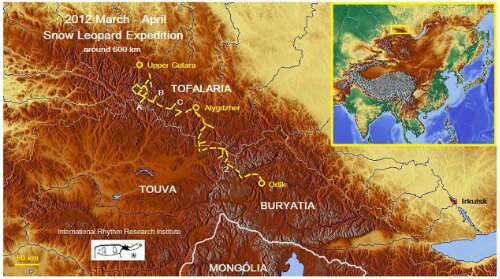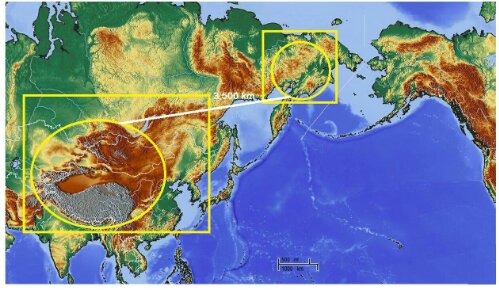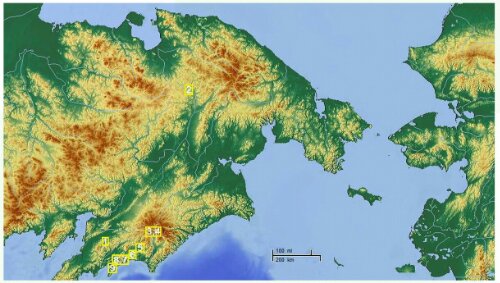http://www.sfgate.com/cgi-bin/article.cgi?f=/c/a/2012/02/12/MNU11MQII3.DTL&type=science&ao=2
Rodney Jackson on a mission to save the snow leopard
Meredith May, Chronicle Staff Writer, SFgate.com
Sunday, February 12, 2012
Biologist Rodney Jackson can pinpoint the moment he transformed from a student of nature to a full-blown conservationist.
While walking along a river in Nepal in 1977, he came upon the skinned carcass of a snow leopard, its front paws curved inward as if in agony, its tail arching skyward like a question mark.
He no longer wanted to simply take wildlife pictures of the endangered Himalayan cat. He knew he would dedicate the rest of his life to saving it.
Jackson photographed the gruesome find, then tracked down the hunter who had killed the animal with a poison spear. He paid $15 for the ice-gray pelt with black rosettes and presented it to Nepalese officials to prove poachers were killing the snow leopard despite international bans.
“I originally went to Nepal after I saw the first pictures of a snow leopard in National Geographic,” said Jackson, 67. “It was such a majestic animal, I needed to see one. And I thought I could take a better picture. I left Nepal with an entirely different idea of what I needed to do.”
World expert
Today, Jackson is one of the world’s foremost experts on the elusive snow leopard, an almost invisible animal that lives on some of the world’s highest peaks in Nepal, Pakistan, India, Siberia, Mongolia and Tibet. One of the hardest animals to count, its population estimate is rough: approximately 4,000 to 7,500 snow leopards spread out over half a million square miles of inhospitable habitat.
Along with his companion, Darla Hillard, Jackson runs the Snow Leopard Conservancy from their modest Sonoma home, a shaded retreat decorated with Tibetan art and prayer flags and lorded over by a 17-year-old house cat named Smudge. They share an office behind the house with two desks, two computers and stacks of research files and books reaching to the ceiling.
With no children in tow, they have been able to maintain the same schedule for the past 30 years: About six months a year in Sonoma, and the rest at dangerous altitudes in subzero temperatures.
“Governments can’t do this conservation work alone,” Jackson said. “I’m convinced guardianship by local communities is the way to go.”
3-time finalist
For the third time, Jackson is a finalist for the prestigious Indianapolis Prize, a $100,000 award given every other September to a conservationist dedicated to a single animal species. Otherwise known as the Nobel Prize for conservation, it’s the world’s leading conservation prize, reserved for those who can demonstrate a species is more likely to be sustained because of their direct actions.
“Definitely the snow leopard is alive today because Rodney is on the job,” said Michael Crowther, president of the Indianapolis Zoological Society, which administers the prize. “There are people who raise money and donate work for the cause, but no one is in his league. He lives a life most people have probably never heard of.”
Shortly after they met, Jackson and Hillard were the first to radio-collar snow leopards, tracking their movements with a VHF antenna and earphones on the peaks of Nepal from 1981 to 1984. With the help of hidden film cameras that were triggered by snow leopards stepping on a buried sensor, the couple obtained unprecedented data on the animal’s movements and behavior.
During that time, Jackson and Hillard learned that snow leopards are largely solitary and leave scrapes in the dirt or urinate on rocks to avoid one another while passing through the same territory.
“They make a large kill every 15 to 20 days – mostly blue sheep,” he said.
But sometimes, when their prey is scarce, snow leopards enter rural mountain villages and kill livestock. When Jackson started his work in the ’70s, he met many high-altitude herders who considered the endangered snow leopard a pest worth killing.
B & B program
Now, the Snow Leopard Conservancy supplies wire mesh to enclose the herders’ pens and keep snow leopards out. The conservancy also created a bed and breakfast program in India, where trekkers pay $12 a night to stay with a local family and eat home-cooked meals. They also pay local guides to take them into the mountains to see snow leopards.
“The villages are starting to see that the snow leopard draws the tourists, so it is more valuable to them alive than dead,” said Jackson, who estimates that five snow leopards are saved for every pen that’s fitted with protective mesh.
Wildlife biologist Jerry Roe of Martinez, who accompanied Jackson on several snow leopard research trips to India from 2002 to 2004, said: “Rodney has a way of connecting with people. Like the wolf is here, the snow leopard is a loaded animal, but Rodney can talk to people in a nonthreatening way. He’s not the Westerner coming in telling people how to live their lives.”
In a sense, Jackson is doing the same thing he loved to do as a boy in South Africa, following animal tracks after school. His father, a member of the British Royal Air Force, met and married his mother in South Africa. He lived in a thatched house with no plumbing, and entertained himself by hiding in the tall grass to watch antelope and leopards. He once found a nest of guinea fowl eggs and excitedly brought it home, only to have the eggs go putrid and explode.
‘Explorers in Africa’
“It all started with this library book, ‘Explorers in Africa.’ I was 10, and fascinated by the big game hunter in the book. My parents never went camping, but as soon as I got a car, I was off,” he said.
Jackson studied zoology at the British-run University of Zimbabwe. Upon graduation, he got a job mapping wildlife for the Canadian government. After writing several letters to his hero, UC Berkeley Professor Aldo Starker Leopold, Jackson was finally admitted to Starker’s zoology and conservation master’s program in the Museum of Vertebrate Zoology.
For his thesis, he put radio collars on male fawns in south Texas to discover why a disproportionate number of male versus female fawns were falling prey to coyotes. (Answer: Males were more apt to hold their ground than flee.)
Jackson had originally planned to return from Berkeley to South Africa to study traditional lowland leopards. But then a woman knocked on his door.
Hillard, who quit her mind-numbing planning job with an idea to do environmental work, met Jackson in the late 1970s when she showed up at the Bodega Bay Institute, where Jackson led environmental hikes. He told her he didn’t have any jobs available, but he could use her help applying for a grant to study snow leopards in Nepal. He’d been turned down by countless other funders who told him it was impossible to radio-collar a Himalayan snow leopard.
She helped him apply and win the Rolex Award for Enterprise, and he invited her on that pioneering radio-collar trip to Nepal. They had to hike 12 days up a snowy mountain to set up their research camp. Hillard took many of the photos – including one in which Jackson and a Sherpa try to sedate a snarling snow leopard – that wound up in a 1986 story in National Geographic.
With changes in technology, Jackson no longer has to use film cameras or bury pressure pads underground and hope a snow leopard steps on it facing the camera to get a good shot. In Ladakh, India, he worked with a PBS film crew to set up 40 infrared, heat and motion sensing cameras that shoot video as well as stills. They got the first images of snow leopards hunting, marking rocks, mating and footage of a mother with her cubs. In one video, a cat gets so close, its breath fogs the lens. The footage became part of the Nature documentary “Silent Roar: Searching for the Snow Leopard.”
Today, Jackson is researching less-invasive methods of studying the snow leopard.
“We are now, in essence, poop collectors,” he said.
He has 500 scats collected so far from Mongolia, India and Nepal, and is working with geneticists overseas and at Texas A&M University. By analyzing waste, researchers can determine the gender, age and individual markers for the animal who left it – which can lead them to know which animals are related and get a much more accurate count of the snow leopard population.
He’s also collecting hair – by leaving out pieces of carpet with dull prongs and few squirts of Calvin Klein Obsession cologne and waiting for the animal to rub on it.
“They go crazy for the stuff,” he said. By analyzing the keratin, he can find out what the snow leopards have been eating in the previous months. He wants to know how much livestock versus prey they consume to determine what effect the predator-proof corrals are having.
Snow Leopard Scouts
Hillard and Jackson are also teaching Himalayan youngsters in a new Snow Leopard Scouts program how to camouflage digital cameras themselves and e-mail their photos to Sonoma. As the children become more excited about the images they capture, Jackson hopes to turn them into a generation of snow leopard guardians.
When he’s in Sonoma, Jackson keeps abreast of snow leopard movements from GPS coordinates sent from the cats’ collars to his inbox. He also tests new cameras in the hills behind his home, capturing images of mountain lions for practice.
Coming back
Recently, he drove his car with the UNCIA personalized plate (scientific name for snow leopard) onto a private organic farm in Glen Ellen, where he has permission to set up hidden wildlife cameras. A half hour’s hike uphill brought him to three different cameras, camouflaged in hard cases and secured by bungee cords to branches or hidden in piles of rocks. Checking the digital card, he found plenty of squirrels, dog walkers, deer and skunk, but there were no big cats on the memory card.
Jackson is used to missing the shot. In the first 15 years of his career, he’d seen only a handful of snow leopards in the wild. He’s come to think of the snow leopard as a gentle ghost, blending in to the beauty and quiet of the landscape.
“It’s almost as if the snow leopard has been imbued by the Buddhist culture it lives in,” Jackson said.
Yet that’s starting to change. Snow leopards were declared vanished from Mount Everest in the mid-1970s but began reappearing in 2003. Since then, he’s seen at least 25.
“They’re coming back,” he said.





